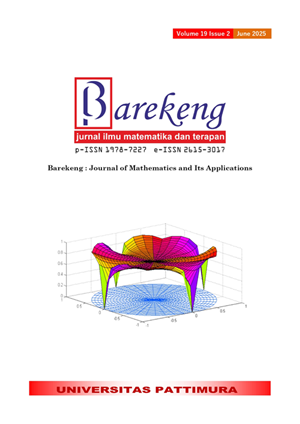STOCK PRICE FORECASTING USING FUZZY C-MEANS AND TYPE-2 FUZZY TIME SERIES
Abstract
Stock prices have unstable movements, so forecasting is needed to decide to invest appropriately according to the strategy. Fuzzy Time Series (FTS) uses fuzzy sets to forecast future time series values using historical data. However, interval partitioning in FTS needs to be considered as it can affect the forecasting results. FCM is applied to solve the problem of interval assignment in the universe of discourse. It allows the evaluation of the distribution of historical data and forming intervals of different sizes. Type 2 Fuzzy Time Series (T2FTS) is an extension of FTS to improve forecasting performance and refine fuzzy relationships. This research aims to improve forecasting accuracy using the Fuzzy C-Means (FCM)-T2FTS combination. This research uses daily data on BBRI stock prices from January 2023 to May 2024, with the variables used being close, high, and low prices. The results showed that determining the interval length using unequal length is more efficient than fixed interval length and can improve model performance, demonstrated from the MAPE values of T2FTS and FCM-T2FTS, which are 2.09% and 1.97%, respectively, the difference between the two MAPEs, is 0.12%. Hence, FCM-T2FTS is 12% more efficient than T2FTS. Therefore, FCM-T2FTS can improve forecasting accuracy.
Downloads
References
S. D. Laskarjati and I. S. Ahmad, “PERBANDINGAN PERAMALAN HARGA SAHAM MENGGUNAKAN AUTOREGRESSIVE INTEGRATED MOVING AVERAGE (ARIMA) DAN FUZZY TIME SERIES MARKOV CHAIN (STUDI KASUS: SAHAM PT INDOFOOD CBP SUKSES MAKMUR TBK),” Jurnal Sains dan Seni ITS, vol. 11, no. 6, pp. 397–404, 2022, doi: 10.12962/j23373520.v11i6.91417.
T. Julian, T. Devrison, V. Anora, and K. M. Suryaningrum, “STOCK PRICE PREDICTION MODEL USING DEEP LEARNING OPTIMIZATION BASED ON TECHNICAL ANALYSIS INDICATORS,” Procedia Comput Sci, vol. 227, pp. 939–947, 2023, doi: 10.1016/j.procs.2023.10.601.
Q. Song and B. S. Chissom, “FORECASTING ENROLLMENTS WITH FUZZY TIME SERIES - PART I,” Fuzzy Sets Syst, vol. 54, no. 1, pp. 1–9, 1993, doi: https://doi.org/10.1016/0165-0114(93)90355-L.
Q. Song and B. S. Chissom, “FORECASTING ENROLLMENTS WITH FUZZY TIME SERIES - Part II,” Fuzzy Sets Syst, vol. 62, no. 1, pp. 1–8, 1994.
N. Van Tinh and N. C. Dieu, “A NEW HYBRID FUZZY TIME SERIES FORECASTING MODEL BASED ON COMBINING FUZZY C-MEANS CLUSTERING AND PARTICLE SWAM OPTIMIZATION,” Journal of Computer Science and Cybernetics, vol. 35, no. 3, pp. 267–292, Aug. 2019, doi: 10.15625/1813-9663/35/3/13496.
Arnita, N. Afnisah, and F. Marpaung, “A COMPARISON OF THE FUZZY TIME SERIES METHODS OF CHEN, CHENG AND MARKOV CHAIN IN PREDICTING RAINFALL IN MEDAN,” in Journal of Physics: Conference Series, Institute of Physics Publishing, Mar. 2020, pp. 1–11. doi: 10.1088/1742-6596/1462/1/012044.
S.-M. Chen, “FORECASTING ENROLLMENTS BASED ON FUZZY TIME SERIES,” Fuzzy Sets Syst, vol. 81, no. 3, pp. 311–319, 1996.
S. T. Li, Y. C. Cheng, and S. Y. Lin, “A FCM-Based Deterministic Forecasting Model For Fuzzy Time Series,” Computers and Mathematics with Applications, vol. 56, no. 12, pp. 3052–3063, Dec. 2008, doi: 10.1016/j.camwa.2008.07.033.
R. M. Pattanayak, S. Panigrahi, and H. S. Behera, “HIGH-ORDER FUZZY TIME SERIES FORECASTING BY USING MEMBERSHIP VALUES ALONG WITH DATA AND SUPPORT VECTOR MACHINE,” Arab J Sci Eng, vol. 45, no. 12, pp. 10311–10325, Dec. 2020, doi: 10.1007/s13369-020-04721-1.
K. Bisht and A. Kumar, “A METHOD FOR FUZZY TIME SERIES FORECASTING BASED ON INTERVAL INDEX NUMBER AND MEMBERSHIP VALUE USING FUZZY C-MEANS CLUSTERING,” Evol Intell, vol. 16, no. 1, pp. 285–297, Feb. 2021, doi: 10.1007/s12065-021-00656-0.
S. Iqbal, C. Zhang, M. Arif, M. Hassan, and S. Ahmad, “A NEW FUZZY TIME SERIES FORECASTING METHOD BASED ON CLUSTERING AND WEIGHTED AVERAGE APPROACH,” Journal of Intelligent and Fuzzy Systems, vol. 38, no. 5, pp. 6089–6098, 2020, doi: 10.3233/JIFS-179693.
E. Egrioglu, C. H. Aladag, and U. Yolcu, “FUZZY TIME SERIES FORECASTING WITH A NOVEL HYBRID APPROACH COMBINING FUZZY C-MEANS AND NEURAL NETWORKS,” Expert Syst Appl, vol. 40, no. 3, pp. 854–857, Feb. 2013, doi: 10.1016/j.eswa.2012.05.040.
H. Qu, M. Sun, J. Zhao, and Y. Zhang, “FUZZY TIME SERIES FORECASTING BASED ON HESITANT FUZZY SETS AND FUZZY C-MEANS CLUSTERING,” in International Conference on Communication Technology Proceedings, ICCT, Institute of Electrical and Electronics Engineers Inc., Oct. 2020, pp. 1514–1518. doi: 10.1109/ICCT50939.2020.9295742.
R. W. Ningrum, B. Surarso, Farikhin, and Y. M. Safarudin, “FORECASTING JAKARTA COMPOSITE INDEX (IHSG) BASED ON CHEN FUZZY TIME SERIES AND FIREFLY CLUSTERING ALGORITHM,” J Phys Conf Ser, vol. 983, no. 1, pp. 1–6, Apr. 2018, doi: 10.1088/1742-6596/983/1/012055.
K. Huarng, “HEURISTIC MODELS OF FUZZY TIME SERIES FOR FORECASTING,” Fuzzy Sets Syst, vol. 123, pp. 369–386, 2001, doi: https://doi.org/10.1016/S0165-0114(00)00093-2.
K. Huarng and H. K. Yu, “A TYPE 2 FUZZY TIME SERIES MODEL FOR STOCK INDEX FORECASTING,” Physica A: Statistical Mechanics and its Applications, vol. 353, no. 1–4, pp. 445–462, Aug. 2005, doi: 10.1016/j.physa.2004.11.070.
A. Nur Hanifah, W. Sulandari, H. Pratiwi, P. Studi Statistika, and U. Sebelas Maret, “PERBANDINGAN PROYEKSI HARGA SAHAM MENGGUNAKAN FUZZY TIME SERIES TIPE 1 DAN 2,” Matematika dan Statistika, vol. 8, 2023.
Abhishekh, S. S. Gautam, and S. R. Singh, “A NEW TYPE 2 FUZZY TIME SERIES FORECASTING MODEL BASED ON THREE-FACTORS FUZZY LOGICAL RELATIONSHIPS,” International Journal of Uncertainty, Fuzziness and Knowldege-Based Systems, vol. 27, no. 2, pp. 251–276, Apr. 2019, doi: 10.1142/S0218488519500120.
A. A. Pramesti, W. Sulandari, S. Subanti, and Y. Yudhanto, “FORECASTING THE COMPOSITE STOCK PRICE INDEX USING FUZZY TIME SERIES TYPE 2,” Radiant, vol. 4, no. 2, pp. 118–133, Aug. 2023, doi: 10.52187/rdt.v4i2.167.
A. Sofro, R. A. Riani, K. N. Khikmah, R. W. Romadhonia, and D. Ariyanto, “ANALYSIS OF RAINFALL IN INDONESIA USING A TIME SERIES-BASED CLUSTERING APPROACH,” BAREKENG: Jurnal Ilmu Matematika dan Terapan, vol. 18, no. 2, pp. 0837–0848, May 2024, doi: 10.30598/barekengvol18iss2pp0837-0848.
P.-C. Chang, Y.-W. Wang, and C.-H. Liu, “THE DEVELOPMENT OF A WEIGHTED EVOLVING FUZZY NEURAL NETWORK FOR PCB SALES FORECASTING,” Expert Syst Appl, vol. 32, no. 1, pp. 86–96, Jan. 2007, doi: 10.1016/j.eswa.2005.11.021.
Copyright (c) 2025 Rineka Brylian Akbar Satriani, Farikhin Farikhin, Bayu Surarso

This work is licensed under a Creative Commons Attribution-ShareAlike 4.0 International License.
Authors who publish with this Journal agree to the following terms:
- Author retain copyright and grant the journal right of first publication with the work simultaneously licensed under a creative commons attribution license that allow others to share the work within an acknowledgement of the work’s authorship and initial publication of this journal.
- Authors are able to enter into separate, additional contractual arrangement for the non-exclusive distribution of the journal’s published version of the work (e.g. acknowledgement of its initial publication in this journal).
- Authors are permitted and encouraged to post their work online (e.g. in institutional repositories or on their websites) prior to and during the submission process, as it can lead to productive exchanges, as well as earlier and greater citation of published works.






1.gif)



